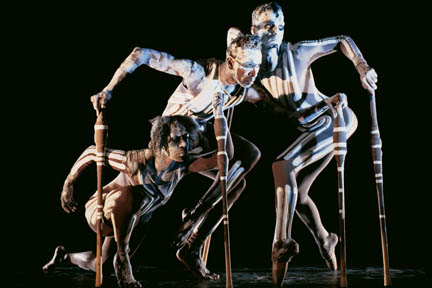

|
Dance performance
plays like a dream
Those in the audience Saturday night for the Bangarra Dance Theatre's performance of "Bush" became one with the aboriginal world, witnessing a show beyond description that left all astonished.
"Bush," choreographed by Stephen Page and Frances Rings and composed by Steve Frances and David Page (no relation), is described as "a lush and contemporary celebration of beauty, ritual and music inspired by the Dreamtime creation stories of Arnhen Land." The words "contemporary" and "beauty" serve no real justice to this work of art, for every movement of the surreal creatures the dancers portrayed left viewers breathless.
The story of Earth's creation (first the landscape, followed by the animals and finally the people), was told though dances, paintings and music of the Rirratijingu clan.
"Creation" (Wirrkul Manda) is the tale of "Two Sisters" from the North Anrnhem Land who sang and danced, creating all living things. Dressed in a humble gray smock, Kathy Baingayngu Marika oozed power and femininity with her crown of silver hair and her ceremonial white-and-black painted makeup. Her presence demanded attention as her every move was filled with wisdom, power and love. The dancers attentively followed her ceremonial dance and listened as she told the story of creation through the eyes of Mother Earth.
Energy and suburb technique filled the stage as the male performers mimicked creatures of the Outback. Set to traditional tribal music with the modern twist of a contagious techno beat, Marika's character of the all-wise aboriginal woman granted the creatures the five senses of sight, sound, smell, taste, and touch.
This story is usually reserved for tribesmen of the highest rank or those held in the highest esteem. But the Marika family gave permission to artistic director Stephen Page to reproduce this haunting and inspiring story.
The entire performance demands respect for the aboriginal land and its people. As I watched I could feel the music and the passion of the dancers.
The opening act draws you deep into the culture of aboriginal society and preps you for movement that mesmerizes throughout.
Audience members found themselves on the edge of their seats on occasion. Performer Sidney Saltner undulated worm-like in "Slither." His movements were like one continuous raindrop as it slides down a wet window pane. This worm brought knowledge from his travels through the Earth, which he then conveyed to the women of the aboriginal tribes.
Even more impressive were the costume designs by Jennifer Irwin. Beautifully made, the costumes and body paint lured viewers in with a visual feast.
The story continued with a moth's "Life Cycle," as choreographed by Page to include three parts: "Leaf," "Caterpillar" and "Moth," all of which parallel man's coming of age. Deborah Brown's intricate fluttering of her moth-like limbs was shadowed by dancer Sani Townson as the duo conveyed the final freedom of breaking free from a cocoon to the first flight of the Australian moth.
The performance continued without intermission, grabbing one's soul without letting go until the end of the journey. Throughout the performance, Marika offered narration through movement. She then held court with the stick spirits (Nganuk or Mimi), creatures with long, painted extra legs and arms, waiting to see if they brought good or bad signs.
Most of all, the dancers' technique and performance quality was not of this world. Their timing was so perfect that the essence of the wondrous creatures seemed to flow within their very veins.
Lastly, the show described the creation of man among the animals that dwelled in the wild Outback. With extraordinary sets and intense lighting, this section was beautifully danced. It included human aboriginal art work danced to life. "Dots" is gorgeously choreographed for three female dancers as their fluid movements mimic the vibrant art form of dot painting. From there the tale of man continued with a series of dances, including "Feather (But'tjui)" a dance that prepared the spirit to move on to the next life.
The presentation closed with the "Ceremony," celebrating the passing of death and spiritual rebirth. "Water" was danced by women in long black dresses who finished with dripping wet hair, symbolizing the beauty of rebirth. This dance then melted into "Passing," again danced by the women. Finally, in "Gift," male dancers executed impeccable modern, erotic movements that were precise and well-rehearsed. Ending with "Clan," the full ensemble vividly performed with spiritual unity that extended to the audience.
Like an enjoyable roller coaster ride that comes to an abrupt stop, the show left me wanting more, though the audience leapt up to deliver a well-deserved standing ovation.

Click for online
calendars and events.